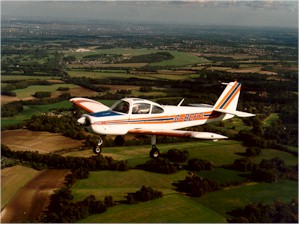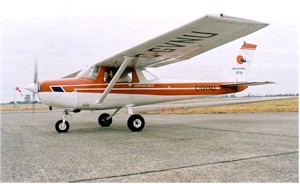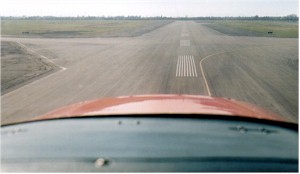
A Fuji FA200 - 160
When you become a seasoned aviator you will have heard many stories of “There I was….” Usually followed by “…upside down with nothing on the clock!”
Well, “there I was”, a nineteen year old who had built many model aeroplanes since the age of six, standing in the doorway at Exeter Flying Club nervously asking about their four pound ($10) trial lesson… I remember it so well. I was introduced to Rufus Heald, a veteran pilot from the RAF and the club’s Chief Flying Instructor; he was to take me on a twenty minute air experience/familiarisation flight.

A Fuji FA200 - 160
We flew in a Japanese aeroplane, a Fuji
FA200 Aero Subaru, it was a misty day but we took off and flew
west to Powderham Castle which we circled before returning to
land on Exeter’s runway 08. I had the controls for
most of this flight; the knowledge I had gained from model
aeroplanes was really useful. I was hooked on flying immediately
of course and twenty eight years later I still have the same
excitement every time I fly, and now I get to sit where Rufus sat
and enjoy the first time excitement reflected in the ‘soon
to be’ aviators faces.
The French call this first flight a “BaptÍme de
l’air”, I love this term since so many people are
reborn with this first experience. So what can you expect
to experience on your own BaptÍme de l’air?

A Cessna 152 at the run-up area
Wherever you go for your first flight
experience in a light aeroplane you will have a similar
experience to mine. The objective of this first flight is
for you to feel the sensations associated with flying and to have
a good experience. Your instructor will give you a basic
introduction to the aeroplane, its structure and systems, and a
safety briefing.
The instructor will start the engine, and then taxi to the run-up
area where he or she will test the engine. Flying discipline is
essential for safety, and one of these disciplines is the run-up
where the engine is tested to ensure that it is fit to fly.
After the run-up the instructor will complete the pre takeoff
vital actions or checks, this is where the systems are checked,
seat belts are tightened, doors are locked, and the controls are
checked.
The approach path is checked and the aeroplane is taxied onto the runway, and when aligned with the centerline the throttle is pushed forward until the engine reaches full power. The speed will build pretty quickly and soon the nose is raised and the aeroplane leaves the ground.

Banking to turn right
It’s a wonderful feeling when the
wheels cease to rumble on the ground and the aeroplane levitates
into the air, and if the air is smooth you may not even notice
until you are a hundred feet up!
Shortly after takeoff the aeroplane will have to turn to leave
the airport circuit for the local area. To turn the
aeroplane will have to bank, in other words one of the wings will
go down, do not be alarmed by this, it does not mean that you
will fall out of the sky!

Like a ship leaving port, all your troubles will remain on the ground, as you look down on the tiny boxes in which we all live, and the Dinky cars in which we all drive. All those problems we face every day diminish in importance as they are put into perspective with their miniscule size in relation to this great vista to which we are witness, as our little flying machine takes us to a viewpoint that too few humans experience.
Your instructor will invite you to try the controls. Don’t be afraid to take control, there is almost nothing you can do that the instructor cannot sort out unless you are a body builder or something!
All too soon you will be descending to land again…

You may have trouble understanding what everyone is saying on the radio; even now aircraft radios can be somewhat incomprehensible! Don’t worry about this, aviators have their own language and we get by… With time you will come to understand the jargon that is spoken by all pilots and controllers.
This flight has two results normally, the most common one is a nightmare for your bank manager…. you’re hooked!
Few people say it’s not for them… but it does happen.
© Michael Peare 2001